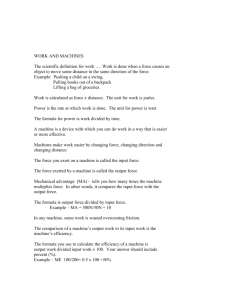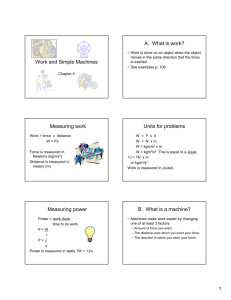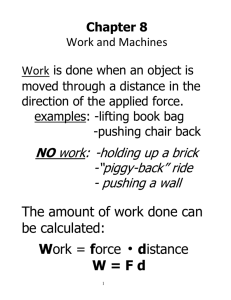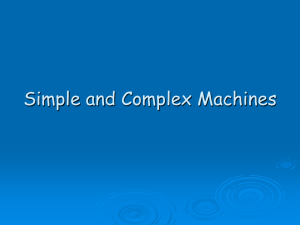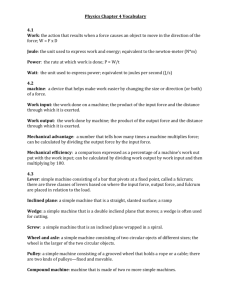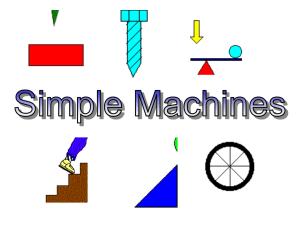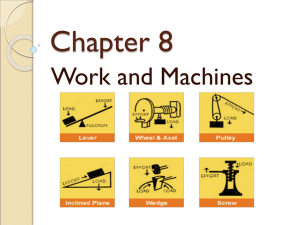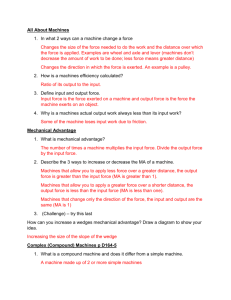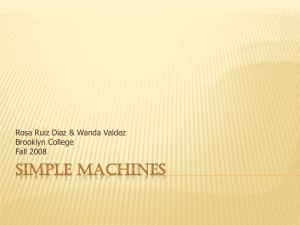Simple Machines: Inclined Planes, Levers, Pulleys & More
advertisement
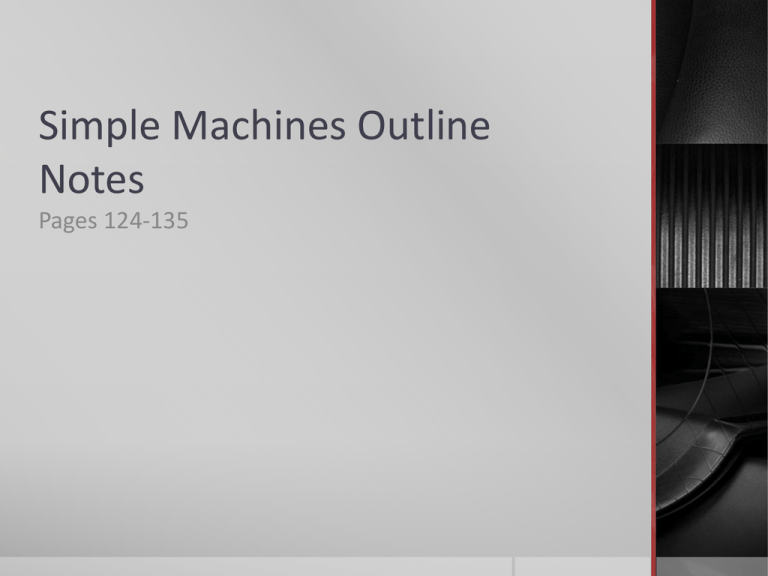
Simple Machines Outline Notes Pages 124-135 There are 6 basic kinds of simple machines: the inclined plane, the wedge, the screw, the lever, the wheel and axle, and the pulley. 1. Inclined Plane Inclined plane: flat, sloped surface Example: ramp A. How It Works Allows you to exert you input force over a longer distance B. Mechanical Advantage You can determine the ideal mechanical advantage of an inclined plane by dividing the length of the incline by its height. Ideal mechanical advantage = length of incline ÷ height of incline 2. Wedge Wedge: device that is thick at one end and tapers to a thin edge at the other end. Examples: zipper, knife A. How It Works Input forces exerted on a wedge causes the output forces to push the wedge into the object. B. Mechanical Advantage The ideal mechanical advantage of a wedge is determined by dividing the length of the wedge by its width. The longer and thinner a wedge is, the greater its mechanical advantage. 3. Screws Screw: inclined plane wrapped around a cylinder Examples: threads in a jar lid, bolt A. How It Works Threads of a screw act like an inclined place to increase the distance over which you exert the input force B. Mechanical Advantage The ideal mechanical advantage of a screw is the length around the threads divided by the length of the screw. 4. Levers Lever: rigid bar that is free to pivot or rotate on a fixed point Fulcrum: fixed point that a lever pivots around A. How It Works When you push down, you exert an input force on the handle which pivots on the fulcrum. B. Mechanical Advantage The ideal mechanical advantage of a lever is determined by dividing the distance from the fulcrum to the input force by the distance from the fulcrum to the output force. Ideal mechanical advantage = distance from fulcrum to input force ÷ distance from fulcrum to output force C. Different Types of Levers 1st class: always change the direction of the input force 2nd class: increase force but do not change the direction of the input force 3rd class: increase distance but do not increase the direction of the input force 5. Wheel and Axle Wheel and axle: simple machine made of 2 circular objects fastened together that rotate about a common axis Examples: screw driver, doorknob A. How It Works Increases to your force but you must exert your force over a long distance. B. Mechanical Advantage You can find the ideal mechanical advantage of a wheel and axle by dividing the radius of the wheel by the radius of the axle. Mechanical advantage = radius of wheel ÷ radius of axis 6. Pulley Pulley: simple machine made of a grooved wheel with a rope or cable wrapped around it A. How It Works You use a pulley by pulling on one end of the rope. Pulleys can decrease the amount of input force needed to lift an object or it can change the direction of your input force. B. Types of Pulleys There are 3 types of pulleys: a fixed pulley (attached to a structure), a moveable pulley (attached to the object you are moving), and a block and tackle (combination of a fixed an a moveable pulley). The ideal mechanical advantage of a pulley is equal to the number of sections of rope that support the object. 7. Simple Machines in the Body A. Living Levers Most of the machines in your body are levers that consist of bones and muscles. B. Working Wedges Your teeth are wedges 8. Compound Machines Compound machine: machine that utilizes 2 or more simple machines The ideal mechanical advantage of a compound machine is the product of the individual ideal mechanical advantages of the simple machines that make it up.


